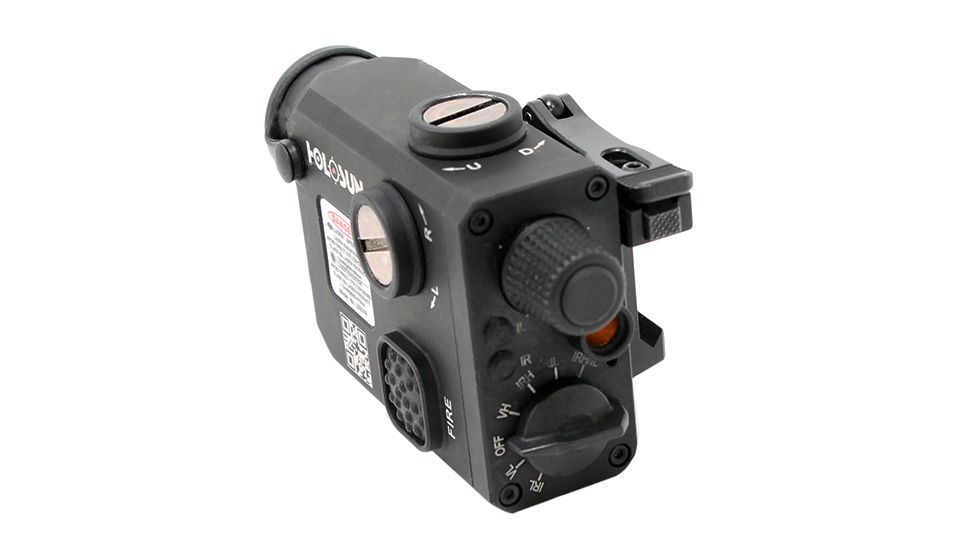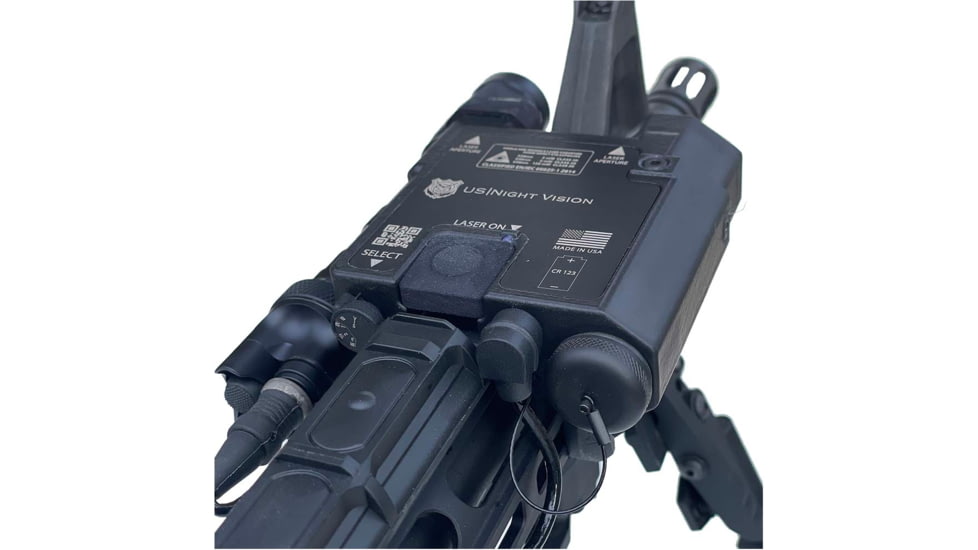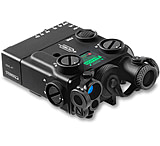An IR laser is a laser that emits infrared light in the non-visible spectrum, which extends from 1300 to 1700 nm. However, IR light is visible with the use of a night vision device, and typically appears as a green laser through the NV device. IR light can be used for aiming, marking, navigating, or observing, since they aren't visible to the naked eye. IR devices can be attached to a firearm or used independently and are available with a variety of capabilities, power outputs, and features. This guide will cover the various aspects of IR devices so you can select the one that meets your needs.![]()
What Are the Classifications of IR Lasers?
Civilian legal versions are considered Class 1, which means they have a low power output and are eye safe. These lasers need to be under 0.7 megawatts (mW) of output power. Military and law enforcement versions are Class 3(b), which are more powerful and can cause permanent blindness if the laser beam is pointed in someone’s eye. These lasers have an output power of at least 25 mW and are heavily regulated and restricted, as they are dangerous if handled improperly. Thankfully, a Class 1 laser is more than enough for almost all civilian applications, so if you're planning on hunting predators at night, you can still clearly see the laser and aim properly without issues.
What Are the Benefits of an Infrared Laser?
 If you have a rifle scope or red dot sight that is night vision compatible, you can adjust the brightness on the optic low enough to be used with a night vision device. However, aligning the optic and the night vision device can be tricky and will typically require the use of high-height aftermarket mounts to make it easier for you to passively aim through your optic. Acquiring and engaging targets using night vision and an optic can be difficult and slow, especially when shooting from unconventional positions. An IR laser allows you to engage targets without having to aim through the optic whilst using night vision. This is especially useful when you need to engage targets at a closer distance, when speed is a priority, or when shooting from unconventional positions. They can also be used as a supporting role for observing, marking, and navigating. You can use the laser to designate or mark a position, highlight an object, point to specific terrain features whilst navigating, and illuminate potential targets/positions when paired with an IR light.
If you have a rifle scope or red dot sight that is night vision compatible, you can adjust the brightness on the optic low enough to be used with a night vision device. However, aligning the optic and the night vision device can be tricky and will typically require the use of high-height aftermarket mounts to make it easier for you to passively aim through your optic. Acquiring and engaging targets using night vision and an optic can be difficult and slow, especially when shooting from unconventional positions. An IR laser allows you to engage targets without having to aim through the optic whilst using night vision. This is especially useful when you need to engage targets at a closer distance, when speed is a priority, or when shooting from unconventional positions. They can also be used as a supporting role for observing, marking, and navigating. You can use the laser to designate or mark a position, highlight an object, point to specific terrain features whilst navigating, and illuminate potential targets/positions when paired with an IR light.
Some IR lasers have both a pointer and illuminating cone. The pointer is the aiming device that can be zeroed to your point of impact. The cone is an illuminator, which can be adjusted for its field of coverage depending on the device and giving you more information about your surroundings.
What Is an IR Illuminator?
 An IR Illuminator is a night vision flashlight that is not visible to the human eye but visible through night vision rifle scopes and binos. IR illuminators brighten your surroundings when there is not enough ambient light available. IR illuminators can use LEDs or lasers for their emitter source. Laser illuminators are subject to FDA regulations, while LED illuminators are not since they are a solid state lighting device, but they do tend to emit a faint red glow at the source. A new laser design called VSCEL illumination (vertical-cavity surface-emitting laser) uses a semiconductor laser that emits light vertically through the substrate, rather than horizontally via a cluster of diodes. This results in better response speed, less impact of temperature change on emission wavelengths, higher efficiency and battery life, and greater luminance.
An IR Illuminator is a night vision flashlight that is not visible to the human eye but visible through night vision rifle scopes and binos. IR illuminators brighten your surroundings when there is not enough ambient light available. IR illuminators can use LEDs or lasers for their emitter source. Laser illuminators are subject to FDA regulations, while LED illuminators are not since they are a solid state lighting device, but they do tend to emit a faint red glow at the source. A new laser design called VSCEL illumination (vertical-cavity surface-emitting laser) uses a semiconductor laser that emits light vertically through the substrate, rather than horizontally via a cluster of diodes. This results in better response speed, less impact of temperature change on emission wavelengths, higher efficiency and battery life, and greater luminance.
While you can purchase IR lights separately, it is convenient to have both capabilities on the same unit that you can activate via a pressure switch or push button. This makes them more functional and effective than carrying around a standalone IR light. You can also purchase IR lights that are separate from the laser device and use a single pressure switch. Having a separate illuminator can be beneficial if you want a more powerful IR light or the ability to swap between lights that are compatible with your pressure switch. An IR laser with a built-in illuminator limits you to the specific output of the device.
How Do You Mount an IR Laser?
Most IR laser devices mount to standard 1913 Picatinny rail systems. However, there are other models that use M-LOK or Keymod mounting systems. Choosing the best option depends on your specific setup, rail, and other accessories that you may already have mounted to the rifle. For example, if you have a fixed front sight or gas block, you may need a device that mounts to the side of the handguard, whether that be M-LOK, Keymod, or a 1913 adapter. This is because you cannot mount all laser aiming devices behind a front sight block. The type of mount setup affects the laser’s trajectory and may dictate what method you use to zero the IR laser.
What Are the Differences Between Converging and Parallel Zero?
 In order to use a laser as an aiming device, you need to “zero” or align the laser with your point of impact. A parallel zero runs parallel through your line of sight and weapon bore. The laser will never meet your bore or point of impact. Using a parallel zero allows you to have the same windage hold no matter the shooting distance. For example, if you have to hold your laser 5 inches to the right to get hits center mass at 50 yards, you will still have to hold to the right at 100 yards or more to impact center mass. This also makes it easier to shoot targets at various distances as there is less to think about when placing the laser. Parallel zeros are more difficult to zero as you are intentionally setting it up so it never meets with the bore of the firearm. It can be hard to tell if the laser is perfectly parallel, which is why you should practice with it repeatedly at various distances to help ensure you are accurate.
In order to use a laser as an aiming device, you need to “zero” or align the laser with your point of impact. A parallel zero runs parallel through your line of sight and weapon bore. The laser will never meet your bore or point of impact. Using a parallel zero allows you to have the same windage hold no matter the shooting distance. For example, if you have to hold your laser 5 inches to the right to get hits center mass at 50 yards, you will still have to hold to the right at 100 yards or more to impact center mass. This also makes it easier to shoot targets at various distances as there is less to think about when placing the laser. Parallel zeros are more difficult to zero as you are intentionally setting it up so it never meets with the bore of the firearm. It can be hard to tell if the laser is perfectly parallel, which is why you should practice with it repeatedly at various distances to help ensure you are accurate.
A converging zero is when your laser is zeroed to meet or converge with the bore at a certain distance. This means your point of impact is accurate with your laser only at a certain distance. Before that distance, the laser starts converging with your bore. After the zeroed distance, the laser diverges with the bore. A converging zero is easier to zero and will be accurate to your impacts at the distance zeroed. The main downside is that it requires you to have different holds depending on your target engagement distance.
What Are Common IR Laser Activation Methods?
Most laser aiming devices use a push button to activate the laser. There may also be multiple buttons or switches to activate separate lasers in the case that the device has both a visible light and IR laser. Models with built in IR illuminators typically use a switch that allows you to change the mode in which the push button activates, such as a white light, IR light, visible laser, IR laser, or a combined version of a light and laser. Momentary and constant on capability is also offered with push buttons depending on how many times or how hard you press the button.
Pressure switches are commonly used with laser aiming devices to allow you to configure the setup to your application. In some cases, you may mount the laser in an area where activating it with a finger or thumb is not possible, so a pressure switch solves this issue by moving the activation button to an area on your rifle that is easy for you to reach. There are many pressure switches available with different features and ergonomics.
Shop IR Lasers & Night Vision Accessories Today!
Using an IR laser helps ensure accurate, effective target engagement when using night vision, and can serve in many supporting roles as well. When choosing your setup, understand that most IR laser modules are not cheap. You may have to factor in other components as well, such as a pressure switch and a night vision device. However, there are many options available for any budget. A minimalist method would be to purchase a simple IR laser with push button activation or toggle switch, such as the Streamlight TLR-VIR II or Steiner TOR-Mini. This allows you to get your foot in the door of low-light shooting. Other options, such as the Steiner DBAL-D2 provide more features and the ability to configure your setup, but at a higher cost. Whatever route you choose, IR lasers improve your effectiveness and ability to operate using night vision.









